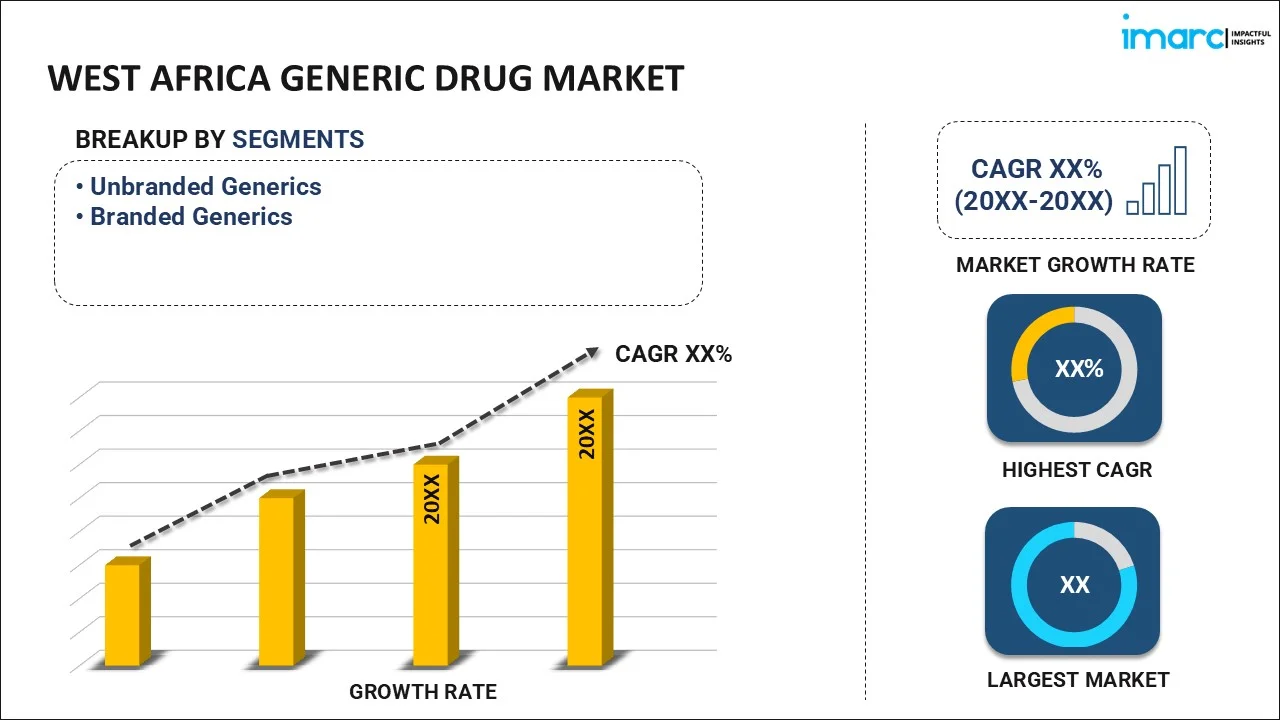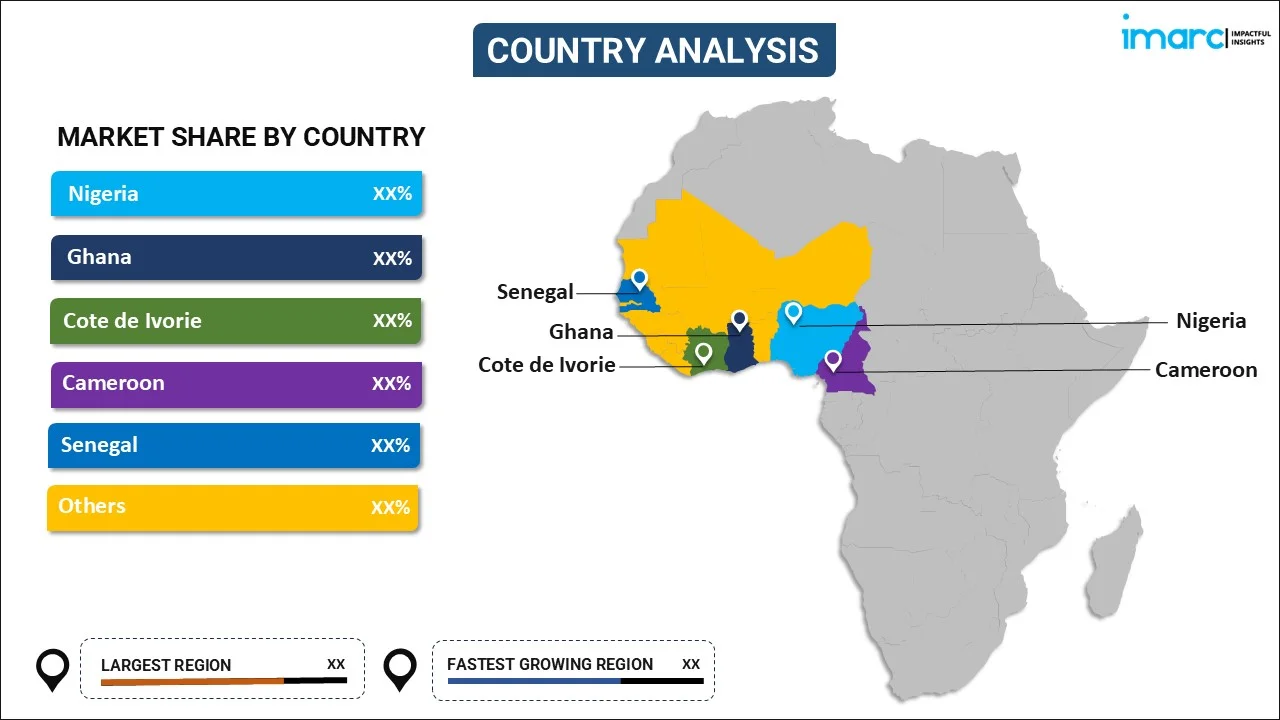
West Africa Generic Drug Market Report by Segment (Unbranded Generics, Branded Generics), Therapy Area (Central Nervous System, Cardiovascular, Dermatology, Genitourinary/Hormonal, Respiratory, Rheumatology, Diabetes, Oncology, and Others), Drug Delivery (Oral, Injectables, Dermal/Topical, Inhalers), Distribution Channel (Retail Pharmacies, Hospital Pharmacies), and Country 2025-2033
Market Overview:
The West Africa generic drug market size reached USD 2.1 Billion in 2024. Looking forward, IMARC Group expects the market to reach USD 3.5 Billion by 2033, exhibiting a growth rate (CAGR) of 5.6% during 2025-2033.
|
Report Attribute
|
Key Statistics
|
|---|---|
|
Base Year
|
2024
|
|
Forecast Years
|
2025-2033
|
|
Historical Years
|
2019-2024
|
|
Market Size in 2024
|
USD 2.1 Billion |
|
Market Forecast in 2033
|
USD 3.5 Billion |
| Market Growth Rate 2025-2033 | 5.6% |
Generic drugs are bioequivalent of branded drugs in terms of their strength, dosage, safety, quality, performance and efficiency. These drugs are more affordable than their counterparts as the manufacturers do not need to invest in marketing or testing the efficiency and strength of these medicines. Since they are proven to be safe and effective as branded drugs, the demand for generic drugs is escalating in the West African region.
The increasing prevalence of infectious diseases, such as malaria, tuberculosis (TB), and acquired immune deficiency syndrome (AIDS), along with the outbreak of meningitis, polio, pandemic influenza, cholera, measles, hepatitis, tetanus and yellow fever, are positively influencing the demand for generic drugs in the West African region. Moreover, governing authorities of various countries are focusing on investing in the healthcare sectors to reduce the number of deaths caused by the lack of essential drugs. This, in turn, is driving the market of generic drugs in the region. However, the sudden outbreak of the coronavirus disease (COVID-19) and the implementation of lockdown restrictions have hampered the production of generic drugs in the region. The market will experience growth once lockdown restrictions are reduced.
Key Market Segmentation:
IMARC Group provides an analysis of the key trends in each segment of the West Africa generic drug market report, along with forecasts at the regional and country levels from 2025-2033. Our report has categorized the market based on segment, therapy area, drug delivery and distribution channel.
Breakup by Segment:

- Unbranded Generics
- Branded Generics
Breakup by Therapy Area:
- Central Nervous System
- Cardiovascular
- Dermatology
- Genitourinary/Hormonal
- Respiratory
- Rheumatology
- Diabetes
- Oncology
- Others
Breakup by Drug Delivery:
- Oral
- Injectables
- Dermal/Topical
- Inhalers
Breakup by Distribution Channel:
- Retail Pharmacies
- Hospital Pharmacies
Breakup by Country:

- Nigeria
- Ghana
- Cote de Ivorie
- Cameroon
- Senegal
- Others
Competitive Landscape:
The competitive landscape of the industry has also been examined along with the profiles of the key players.
Report Coverage:
| Report Features | Details |
|---|---|
| Base Year of the Analysis | 2024 |
| Historical Period | 2019-2024 |
| Forecast Period | 2025-2033 |
| Units | Billion USD |
| Segment Coverage | Segment, Therapy Area, Drug Delivery, Distribution Channel, Country |
| Countries Covered | Nigeria, Ghana, Cote de Ivorie, Cameroon, Senegal, Others |
| Customization Scope | 10% Free Customization |
| Post-Sale Analyst Support | 10-12 Weeks |
| Delivery Format | PDF and Excel through Email (We can also provide the editable version of the report in PPT/Word format on special request) |
Key Questions Answered in This Report:
- How has the West Africa generic drug market performed so far and how will it perform in the coming years ?
- What has been the impact of COVID-19 on the West Africa generic drug market ?
- What are the key regional markets ?
- What is the breakup of the market based on the segment ?
- What is the breakup of the market based on the therapy area ?
- What is the breakup of the market based on the drug delivery ?
- What is the breakup of the market based on the distribution channel ?
- What are the various stages in the value chain of the industry ?
- What are the key driving factors and challenges in the market ?
- What is the structure of the West Africa generic drug market and who are the key players ?
- What is the degree of competition in the market ?
Need more help?
- Speak to our experienced analysts for insights on the current market scenarios.
- Include additional segments and countries to customize the report as per your requirement.
- Gain an unparalleled competitive advantage in your domain by understanding how to utilize the report and positively impacting your operations and revenue.
- For further assistance, please connect with our analysts.
 Inquire Before Buying
Inquire Before Buying
 Speak to an Analyst
Speak to an Analyst
 Request Brochure
Request Brochure
 Request Customization
Request Customization




.webp)




.webp)












